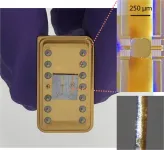Tiny chip-based device performs ultrafast modulation of X-rays
New optics-on-a-chip device paves way to capturing fast chemical, material and biological processes
2021-04-20
(Press-News.org) WASHINGTON -- Researchers have developed new x-ray optics that can be used to harness extremely fast pulses in a package that is significantly smaller and lighter than conventional devices used to modulate x-rays. The new optics are based on microscopic chip-based devices known as microelectromechanical systems (MEMS).
"Our new ultrafast optics-on-a-chip is poised to enable x-ray research and applications that could have a broad impact on understanding fast-evolving chemical, material and biological processes," said research team leader Jin Wang from the U.S Department of Energy's Argonne National Laboratory. "This could aid in the development of more efficient solar cells and batteries, advanced computer storage materials and devices, and more effective drugs for fighting diseases."
In The Optical Society (OSA) journal Optics Express, the researchers demonstrated their new x-ray optics-on-a-chip device, which measures about 250 micrometers and weighs just 3 micrograms, using the x-ray source at Argonne's Advanced Photon Source synchrotron. The tiny device performed 100 to 1,000 times faster than conventional x-ray optics, which tend to be bulky.
"Although we demonstrated the device in a large x-ray synchrotron facility, when fully developed, it could be used with conventional x-ray generators found in scientific labs or hospitals," said Wang. "The same technology could also be used to develop other devices such as precise dosage delivery systems for radiation therapy or fast x-ray scanners for non-destructive diagnostics."
Capturing fast processes
X-rays can be used to capture very fast processes such as chemical reactions or the quickly changing dynamics of biological molecules. However, this requires an extremely high-speed camera with a fast shutter speed. Because many materials that are opaque to light are transparent to x-rays it can be difficult to improve the speed of shutters effective for x-rays.
To solve this challenge, the research team, consisting of scientists from Argonne's Advanced Photon Source and Center for Nanoscale Materials, turned to MEMS-based devices. "In addition to being used in many of the electronics we use daily, MEMS are also used to manipulate light for high-speed communication," said Wang. "We wanted to find out if MEMS-based photonic devices can perform similar functions for x-rays as they do with visible or infrared light."
In the new work, the researchers show that the extremely small size and weight of their MEMS-based shutter allows it to oscillate at speeds equavilent to about one million revolutions per minute (rpm). The researchers leveraged this high speed and the MEMS material's x-ray diffractive property to create an extremely fast x-ray shutter.
Boosting shutter speed
Using their new optics-on-a-chip with x-rays produced by the Advanced Photon Source, the researchers demonstrated that it could provide a stable shutter speed as fast as one nanosecond with an extremely high on/off contrast. This could be used to extract single x-ray pulses from the source, even if the pulses were only 2.8 nanoseconds apart from each other.
"We show that our new chip-based technology can perform functions not possible with conventional large optics," said Wang. "This can be used to create ultrafast probes for studying fast processes in novel materials."
The researchers are now working to make the devices more versatile and robust so that they can be used continuously over long periods of time. They are also integrating the peripheral systems used with the tiny chip-based MEMS devices into a deployable stand-alone instrument.
INFORMATION:
The work was supported by DOE's Office of Science. The Advanced Photon Source and Center for Nanoscale Materials are DOE Office of Science user facilities.
Paper: P. Chen, I. W. Jung, D. A. Walko, Z. Li, Y. Gao, T. Mooney, G. K. Shenoy, D. Lopez, J. Wang, "Optics-on-a-chip for ultrafast manipulation of 350-MHz hard x-ray pulses," Opt. Express, 29, 9, 13624-13640 (2021).
DOI: https://doi.org/10.1364/OE.411023.
About Optics Express
Optics Express reports on scientific and technology innovations in all aspects of optics and photonics. The bi-weekly journal provides rapid publication of original, peer-reviewed papers. It is published by The Optical Society (OSA) and led by Editor-in-Chief James Leger of the University of Minnesota, USA. Optics Express is an open-access journal and is available at no cost to readers online at OSA Publishing.
About The Optical Society
Founded in 1916, The Optical Society (OSA) is the leading professional organization for scientists, engineers, students and business leaders who fuel discoveries, shape real-life applications and accelerate achievements in the science of light. Through world-renowned publications, meetings and membership initiatives, OSA provides quality research, inspired interactions and dedicated resources for its extensive global network of optics and photonics experts. For more information, visit osa.org.
Media Contact: mediarelations@osa.org
[Attachments] See images for this press release:

ELSE PRESS RELEASES FROM THIS DATE:
2021-04-20
Engineered, autonomous machines combined with artificial intelligence have long been a staple of science fiction, and often in the role of villain like the Cylons in the "Battlestar Galactica" reboot, creatures composed of biological and engineered materials. But what if these autonomous soft machines were ... helpful?
This is the vision of a team of Penn State and U.S. Air Force researchers, outlined in a recent paper in Nature Communications. These researchers produced a soft, mechanical metamaterial that can "think" about how forces are applied to it and respond via programmed reactions. ...
2021-04-20
People who regularly use psychoactive substances report experiencing a variety of negative impacts since the COVID-19 pandemic began, including increased usage and fear of relapse or overdose, highlighting the need for improved supports and services, including better access to safe supply programs, according to a new CAMH survey published in the International Journal of Drug Policy.
"People who use drugs have been negatively impacted by the pandemic in ways that put them at greater risk for experiencing substance and health-related harms, including overdoses and a decreased ability to mitigate risk behaviours," ...
2021-04-20
Leesburg, VA, April 20, 2021--An award-winning Scientific Electronic Exhibit to be presented at the ARRS 2021 Virtual Annual Meeting found non-contrast pituitary MRI for central precocious puberty (CPP), growth hormone deficiency (GHD), and short stature (SS) has similar diagnostic yield compared to the standard contrast-enhanced protocol.
"Microadenomas, a common justification for contrast administration, may not influence management in this patient population," wrote first author Jennifer Huang of Vanderbilt University in Nashville, TN, adding "minimal inconvenience would be added for the few patients who would need to return for contrast-enhanced MRI for definitive diagnosis."
Huang and colleagues performed a retrospective review of pediatric pituitary MRI studies from 2010-2019 ...
2021-04-20
Leesburg, VA, April 20, 2021--An award-winning Scientific Electronic Exhibit to be presented at the ARRS 2021 Virtual Annual Meeting found no statistically significant threshold for increased renal transplant biopsy risk based on systolic (SBP), diastolic (DBP), or mean arterial (MAP) blood pressure alone.
"When these metrics are combined," first author Winston Wang of the Mayo Clinic Arizona cautioned, "the risk of complication is significantly higher when the SBP is >= 180 mm Hg, DBP is >= 95 mm Hg, and MAP is >= 116 mm Hg."
Wang and team's review of consecutive ...
2021-04-20
Researchers have found a causal link between caesarean section birth, low intestinal microbiota and peanut sensitivity in infants, and they report the effect is more pronounced in children of Asian descent than others, in a recently published paper in the journal of the American Gastroenterological Association.
"It's important to know what predicts or increases risk of food sensitivities because they predict which infants will go on to develop asthma and other types of allergies," said Anita Kozyrskyj, pediatrics professor in the University of Alberta's Faculty of Medicine & Dentistry ...
2021-04-20
Professor Bin He's team at Carnegie Mellon University, in collaboration with the Mayo Clinic, has discovered that fast oscillations in scalp-recorded electroencephalography can pinpoint brain tissues responsible for epileptic seizures. The collaborative research, recently published in the Proceedings of the National Academy of Sciences (PNAS), leverages noninvasive EEG technology along with the development of a novel machine learning algorithm to automatically identify and delineate concurrent high-frequency oscillations and epileptiform spikes, a key link related to epilepsy. In the near future, these findings may be harnessed to rethink imaging and treatment options for epilepsy patients.
More than ...
2021-04-20
An expansive project led by Michigan State University's Lars Brudvig is examining the benefits, and limits, of environmental restoration on developed land after humans are done with it.
Experts estimate there are up to 17 million square miles of land worldwide that have been altered by humans -- through cultivation say -- and then abandoned. That's more than four times the size of the continental United States.
Once humans change a landscape, their impacts linger long after they've moved on. However, humans can heal some of that damage by working to restore the land to its natural state. ...
2021-04-20
The familiar murkiness of waters in the Gulf of Mexico can be off-putting for beachgoers visiting Galveston Island. Runoff from the Mississippi River makes its way to local beaches and causes downstream water to turn opaque and brown. Mud is one factor, and river runoff is another. However, concern tends to ratchet up a notch when pollution enters the river runoff discussion on a national scale, specifically when smaller, navigable intrastate bodies of water push pollution into larger interstate waters often involved in commerce (i.e. the Mississippi River, Great Lakes, Ohio River).
A recently published research analysis in the journal Science, co-authored by Victor Flatt, Dwight Olds Chair in Law at the University of Houston Law ...
2021-04-20
Published in the Advanced Functional Materials, University of Minnesota researcher Hongbo Pang led a cross-institutional study on improving the efficacy of nucleotide-based drugs against prostate cancer and bone metastasis.
In this study, Pang and his research team looked at whether liposomes, when integrated with the iRGD peptide, will help concentrate antisense oligonucleotides (ASOs) into primary prostate tumors and its bone metastases. Liposomes are used as a drug carrier system, and ASOs are a type of nucleotide drug.
More importantly, they investigated whether this system helps more drugs across the vessel wall and deeply into the tumor tissue. This is critical because, although nucleotide drugs offer unique advantages ...
2021-04-20
Mass extinctions are known as times of global upheaval, causing rapid losses in biodiversity that wipe out entire animal groups. Some of the doomed groups linger on before going extinct, and a team of scientists found these "dead clades walking" (DCW) are more common and long-lasting than expected.
"Dead clades walking are a pattern in the fossil record where some animal groups make it past the extinction event, but they also can't succeed in the aftermath," said Benjamin Barnes, a doctoral student in geosciences at Penn State. "It paints the pictures of a group consigned to an eventual extinction."
The scientists found 70 of the 134 orders of ancient sea-dwelling invertebrates they examined could ...
LAST 30 PRESS RELEASES:
[Press-News.org] Tiny chip-based device performs ultrafast modulation of X-rays
New optics-on-a-chip device paves way to capturing fast chemical, material and biological processes








